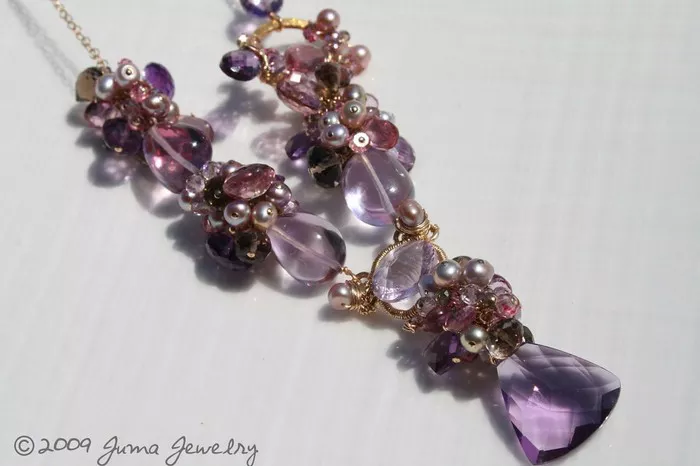In the world of gemstones, Purple Sapphire and Amethyst stand out for their captivating hues and mesmerizing allure. While both exude a regal purple charm, they are distinct in their composition, origin, and properties. Understanding the disparities between these two gems is crucial for gem enthusiasts, collectors, and buyers alike. In this comprehensive guide, we delve deep into the divergences between Purple Sapphire and Amethyst, shedding light on 6 major differences to empower you with the knowledge needed to make an informed decision.
1. Geological Formation and Origin
Purple Sapphire, also known as Violet Sapphire, belongs to the corundum mineral family. It is formed under intense geological conditions, primarily in metamorphic and igneous rocks. The presence of trace elements such as iron and titanium lends the stone its distinctive purple hue. Quality Purple Sapphires are predominantly sourced from regions like Sri Lanka, Madagascar, and Tanzania.
In contrast, Amethyst is a variety of quartz, which is one of the most abundant minerals on Earth. The vibrant purple color of Amethyst is attributed to the presence of iron impurities within the quartz crystal lattice. This gemstone is typically found in geodes within volcanic rocks, with major deposits located in Brazil, Uruguay, and Zambia.
2. Chemical Composition
While both Purple Sapphire and Amethyst boast purple tones, their chemical compositions vary significantly. Purple Sapphire is primarily composed of aluminum oxide (Al2O3) with traces of iron (Fe) and titanium (Ti). The precise ratio of these elements determines the saturation and hue of the purple coloration in the gemstone.
On the other hand, Amethyst belongs to the quartz group, characterized by its silicon dioxide (SiO2) composition. The presence of iron within the quartz structure imparts the distinctive purple color to Amethyst. Unlike Purple Sapphire, Amethyst does not contain aluminum or titanium in its chemical makeup.
3. Hardness and Durability
In terms of hardness, Purple Sapphire and Amethyst exhibit notable disparities. Purple Sapphire ranks 9 on the Mohs scale of mineral hardness, making it one of the hardest gemstones available, second only to diamond. This exceptional hardness ensures that Purple Sapphire is highly resistant to scratches and abrasions, rendering it suitable for everyday wear in various jewelry settings.
Amethyst, while still relatively durable, ranks 7 on the Mohs scale. While it can withstand daily wear, it is more susceptible to scratches compared to Purple Sapphire. Care should be taken to protect Amethyst jewelry from hard knocks and abrasive surfaces to preserve its luster and integrity over time.
4. Color Variations and Rarity
Both Purple Sapphire and Amethyst exhibit a spectrum of purple shades, ranging from pale lilac to deep violet. However, the nuances in color and saturation differ between the two gemstones. Purple Sapphire often displays a more intense, vivid purple hue with subtle undertones of pink or blue, depending on its origin and mineral composition.
Amethyst, on the other hand, can vary widely in color intensity and tone. While deep, saturated purple is highly prized, lighter shades of lavender and mauve are also coveted for their delicate beauty. Natural color zoning, caused by variations in the concentration of iron impurities during formation, adds to the allure of Amethyst. Despite its abundant availability, top-quality deep purple Amethyst remains relatively rare and commands premium prices in the market.
5. Optical Properties and Clarity
The optical properties of Purple Sapphire and Amethyst contribute to their visual appeal and value. Purple Sapphire exhibits excellent transparency and clarity, with high-quality specimens showcasing minimal inclusions and blemishes. This clarity allows light to pass through the gem unhindered, resulting in exceptional brilliance and sparkle.
In contrast, Amethyst often contains visible inclusions, known as “silk,” which are fine needle-like rutile or hematite crystals. While these inclusions are common in natural Amethyst and do not significantly detract from its beauty, they can affect transparency and overall clarity. Some varieties of Amethyst, such as the prized “Rose de France,” are valued for their delicate pinkish-purple hue and clarity.
See Also: Who Can Wear Purple Sapphires
6. Cultural and Symbolic Significance
Throughout history, both Purple Sapphire and Amethyst have held cultural and symbolic significance across various civilizations. Purple Sapphire has been associated with nobility, wisdom, and royalty, owing to its rich purple color and rarity. In ancient times, it was believed to possess protective properties and was often worn by royalty and clergy as a symbol of power and virtue.
Amethyst, known as the “stone of sobriety” in Greek mythology, was believed to ward off drunkenness and promote clarity of mind. It has been revered for its calming and purifying properties, symbolizing peace, balance, and inner strength. Amethyst has also been associated with spiritual enlightenment and is often used in meditation practices to facilitate emotional healing and spiritual growth.
Conclusion
While Purple Sapphire and Amethyst share a common purple hue, their differences in geological origin, chemical composition, physical properties, and cultural significance make each gemstone unique and distinctive. Whether you’re drawn to the rare beauty of Purple Sapphire or the timeless elegance of Amethyst, understanding these six major differences will guide you in selecting the perfect gemstone to suit your preferences, style, and budget. Whether adorning a piece of jewelry or serving as a cherished collector’s item, both Purple Sapphire and Amethyst will continue to captivate hearts and minds with their enduring allure and enchanting charm.


